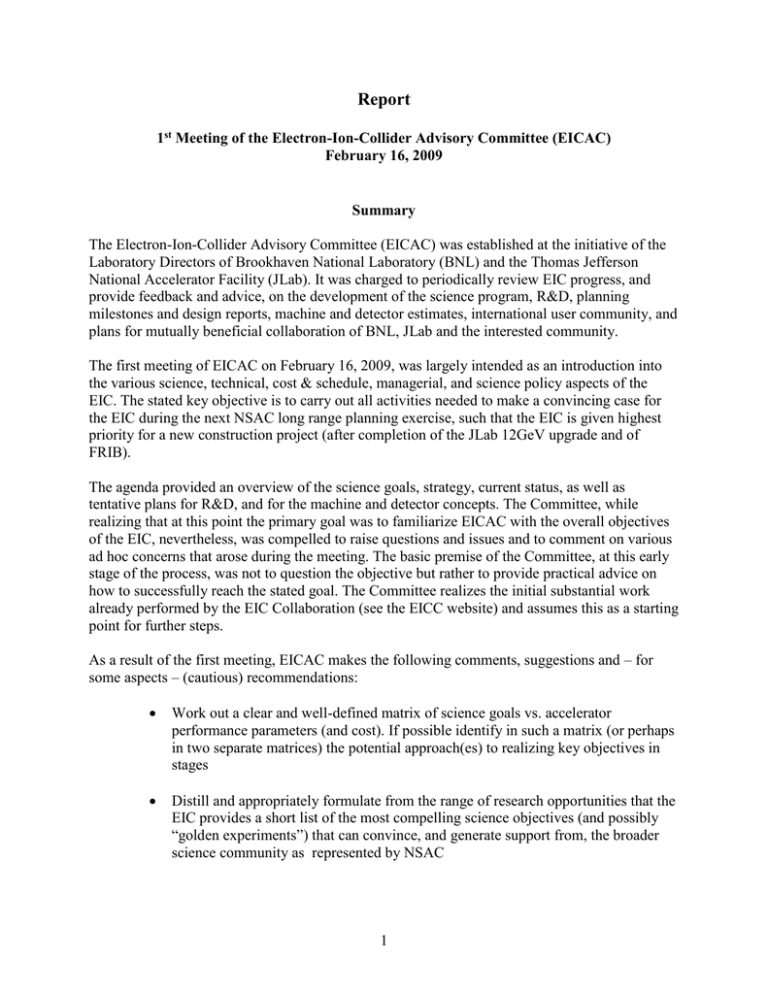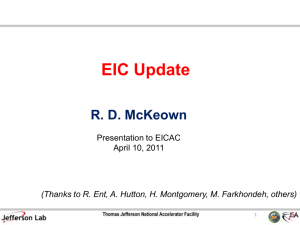Report from EIC Advisory Committee
advertisement

Report 1st Meeting of the Electron-Ion-Collider Advisory Committee (EICAC) February 16, 2009 Summary The Electron-Ion-Collider Advisory Committee (EICAC) was established at the initiative of the Laboratory Directors of Brookhaven National Laboratory (BNL) and the Thomas Jefferson National Accelerator Facility (JLab). It was charged to periodically review EIC progress, and provide feedback and advice, on the development of the science program, R&D, planning milestones and design reports, machine and detector estimates, international user community, and plans for mutually beneficial collaboration of BNL, JLab and the interested community. The first meeting of EICAC on February 16, 2009, was largely intended as an introduction into the various science, technical, cost & schedule, managerial, and science policy aspects of the EIC. The stated key objective is to carry out all activities needed to make a convincing case for the EIC during the next NSAC long range planning exercise, such that the EIC is given highest priority for a new construction project (after completion of the JLab 12GeV upgrade and of FRIB). The agenda provided an overview of the science goals, strategy, current status, as well as tentative plans for R&D, and for the machine and detector concepts. The Committee, while realizing that at this point the primary goal was to familiarize EICAC with the overall objectives of the EIC, nevertheless, was compelled to raise questions and issues and to comment on various ad hoc concerns that arose during the meeting. The basic premise of the Committee, at this early stage of the process, was not to question the objective but rather to provide practical advice on how to successfully reach the stated goal. The Committee realizes the initial substantial work already performed by the EIC Collaboration (see the EICC website) and assumes this as a starting point for further steps. As a result of the first meeting, EICAC makes the following comments, suggestions and – for some aspects – (cautious) recommendations: Work out a clear and well-defined matrix of science goals vs. accelerator performance parameters (and cost). If possible identify in such a matrix (or perhaps in two separate matrices) the potential approach(es) to realizing key objectives in stages Distill and appropriately formulate from the range of research opportunities that the EIC provides a short list of the most compelling science objectives (and possibly “golden experiments”) that can convince, and generate support from, the broader science community as represented by NSAC 1 As a principal approach to a concise list of science objectives and facility parameters (including detectors), aggressively pursue the planned series of structured workshops Further develop the schedule including approximate resource-loading, to provide a timeline for major decisions (including, if at all possible, site decision), technical developments, and (staged) realization In particular, strive for a timeline (under reasonable assumptions) that provides for data taking before 2020 An obvious important near-term activity is to work out a detailed and comprehensive R&D plan. The proposed common effort between BNL and JLab should focus, to a substantial extent, on R&D for technologies needed for both facility concepts It would be desirable for the EICAC to see a detailed common plan at the next meeting with deliverables & resources needed to reach a buildable design for the LRP. This might also help to reduce the considerable range of possibilities being discussed to a more concrete set of scenarios for the next meeting. These suggestions should be all seen as a first preliminary response from the Committee to a time-constrained, compact presentation and discussion of the many aspects of the project(s). This is also true for several specific comments in the detailed report that follows below. The Committee feels that the project is clearly one that is matched to the mission and capabilities of national laboratories and applauds the joint initiative taken by BNL and JLab. It also is impressed by the enthusiasm and commitment of the laboratories as well as that of the individual staff. As such, it strongly supports the focused effort that both laboratories plus the community are willing to invest in this goal. The suggestions listed above (and the detailed comments given below) are meant to help strengthen the approach towards this ambitious project. Detailed Report The Electron-Ion-Collider has been seen by the nuclear physics community as a major and important new tool for QCD studies for well more than a decade now. The discussion in the US has been documented, for example, in the 2002 and 2007 NSAC Long Range Plans. The recent ground work laid in precision measurements of electron-proton collisions at the HERA collider at DESY, in electron-hadron/nucleus collisions both at HERMES (DESY) and JLab, and in hadron induced ion-collisions at BNL have contributed fundamental information on QCD in the perturbative and non-perturbative regimes. It has also raised important new questions that the EIC community feels require the substantial advances in experimental capabilities that the EIC will provide. 2 The present EIC Advisory Committee (EICAC) was established at the initiative of the Laboratory Directors of Brookhaven National Laboratory (BNL) and the Thomas Jefferson National Accelerator Facility (JLab). The list of committee members is attached to this Report as Appendix A. The EICAC was charged to periodically review EIC progress, and provide feedback and advice, on the development of: the science program, R&D, planning milestones and design reports, machine and detector estimates, international user community, and plans for mutually beneficial collaboration of BNL, JLab and the interested community. The full charge is attached as Appendix B. The first meeting of EICAC on February 16, 2009, was largely intended as an introduction into the various science, technical, managerial, and science policy aspects of the EIC. The complete agenda is attached as Appendix C. The stated key objective is to carry out all activities needed to make a convincing case for the EIC during next NSAC long range planning exercise expected in ~2012, such that the EIC is given highest priority for a new construction project (after completion of the JLab 12GeV upgrade and of FRIB). The agenda of this first meeting provided an overview of the science goals, strategy, current status, as well as tentative plans for R&D, and for the machine and detector concepts. In the following we present the main aspects of the Committee’s discussion during this first meeting. Before doing that we feel it is important to make (or repeat) some general remarks. This was a first (largely briefing-type) meeting for the Committee and obviously much too short and ad hoc to expect a balanced consensus report (with desired substance, one might add, since consensus is always possible at a superficial level). In the spirit of open exchange (and hopefully constructive criticism, i.e. the expectation that unfiltered reactions from the Committee members might drive best the future discussion), we present a collection of statements from individual Committee members. We should note that most of them seem to reflect a broader opinion in the Committee since they did not trigger violent disagreement from other members but, nevertheless, this is a snapshot of individual opinions, based on limited information and opportunity to have in-depth discussions, and should be seen as such. The comments, in no particular order, read as follows: ”In order to obtain maximal support for the EIC it is vital to make the physics case as convincing as possible. Although it may be most effective to formulate, at the end, the scientific goals by a small number of short and concise statements, it will first be necessary to perform detailed, extensive, and thorough studies and simulations of how these goals can be reached. Examples include the search for gluon saturation (what are the decisive and convincing experimental signatures?), or the measurement of diffractive final states. I therefore recommend and support very much to continue and intensify the planned series of workshops at which these issues have to be addressed.” “It is important to complete the matrix of science opportunities versus machine requirements, and versus approximate costs. This tool will aid the Committee and the community in framing the science options. Within this planning exercise, the paramount need is to identify a short list of “golden” experiments. Here, “short” should be of the order 3-4. And we would welcome two lists, one for a stage-1 machine and a second for a stage-2 machine. (Of course it would be good if an overlap existed). We would urge the collaboration that “less is more” at this stage, especially in making the case to the broader community. Of course, the study of QCD is a 3 sophisticated topic and there is a place for advanced, high-level discussions, but framing a clear argument with outcomes all nuclear physicists can buy into is vital. As was stated by a member from laboratory management in the opening session, selling this to the NSAC Long Range Plan group in 2012 is essential and represents a challenge that cannot afford a misstep. If the Collaboration is truly interested in expediting the approval process – in time for the Long Range Plan in 2012, and DOE Critical Decisions (CD’s) steps afterwards – then it would be prudent to converge on a site decision and machine plan as early as at all possible. This is simply a practical remark, and not meant to be a recommendation to rush decisions. The Collaboration is commended for working together across laboratory lines. Extending the reach to international groups engaged in similar efforts might be a wise venture. It could lead to learning, cooperation, and a better synchronization of efforts and timelines. I personally also strongly resonate with the idea of working out in more detail the BNL 4 GeV machine including detector demands (that have been advocated by others). It is important to know what the detector must do before any R&D money would be provided to prove such a detector can work. So far, the R&D suggestions for detector studies are totally inadequate and not thought out carefully in my opinion.” “The EICAC takes note of the status of the conceptual detector design and the list of detector R&D topics presented. In order to achieve by 2012 a credible detector design and to demonstrate first significant results of dedicated detector R&D, the effort has to be strengthened significantly. In the near future, based on a focused science program and on simulations, a detector concept with corresponding physics performance should be developed, the machine-detector interface designed, and critical R&D topics identified. The planning, including milestones and resources needed should be worked out. The strong support by both labs will be essential. The establishment of the core group at BNL, as presented, is considered an important step in this direction.” “The time frame for the project is a very important aspect. Time scales beyond 2020 for a start of data taking are de-motivating, and unjustified it seems to me. We were presented with staged approaches, for example for eRHIC, which requires limited civil engineering and with a relatively modest price tag of 150 M$ for the accelerator. Detector costs can presumably be shared by the collaboration. The cost of the staged project is at the 10% level of what has been invested in RHIC, and comparable to the cost of many single purpose projects planned or envisaged in the nuclear and particle physics communities, so it is not obvious why the lead time should be so long. The laboratory(s) (in this example BNL) should investigate possibilities to have a more aggressive time scale, while the EIC collaboration should present a clear and straightforward case for a project of this scope, keeping in mind that the staged project does not already need to reach all the final project goals.” “A few comments from the meeting, on top of what others may have expressed: It would be useful for the next meeting to get some more details (e.g. a breakdown) of the present manpower resources for carrying out the various studies, for the machine but in particular also for the planned detailed detector and physics studies. At that meeting it would be also good to have a closer look at, perhaps updated, cost projections and their details. In particular, one should make sure that the two laboratories apply identical algorithms for the costing (this is perhaps the case 4 already but should be spelled out in some detail). By the next meeting we would also like to have the timeline available on when we could expect what results to be completed for the preparation of the document for the long range planning, i.e. on the machine studies, on detector conceptual design, and on the detailed performance/physics studies, so that the EICAC would be in a position to monitor the milestones over time.” “Of the two alternatives presented, the JLAB concept is in essence a new facility even though built around the existent CEBAF. As such, a lot of (basic) accelerator design work has to be done. The ion ring has a number of challenging beam parameters (e.g. the ultra-short ion bunches, beam lifetimes, figure-8 rings etc.). This is not to ignore the challenges for eRHIC. The common R&D effort should focus on the technologies needed for both approaches: cooling, MDI, beam-beam investigations, the various crabbing schemes. Beyond this, an R&D plan involving both labs for the eventual unified proposal will need to be developed. It would be good to see a detailed common plan addressing these issues at the next meeting, with deliverables and resources needed to get to a buildable design for the NSAC Long Range Plan in 2012.” ”Given the anticipated timeline in order to be ready to propose a solid project at the next NSAC Long Range Plan process, it seems that it now is about the time to narrow down the scope of the project rather than exploring various possibilities in accelerator technologies, possible luminosities, and energies. It would be very useful to concentrate on a more specific scenario including – if at all possible – a site selection, especially to start the project on a reasonable time scale. The proposed staging approach seems very useful. As an example, the low-energy option at BNL seems attractive which could be consistent with some of the key physics goals. Its cost estimate seems to be more realistic; it is difficult to imagine a billion dollar project could start on a comparable time scale.” ”It would appear that it would be better to have a detailed review of the designs of the accelerator(s) by more accelerator experts if possible. A few specific comments are listed in the following; in my opinion, any one of them may have a possibility to be a show stopper and thus needs to be carefully considered. For eRHIC: For the ring-ring scheme, the Hirata-Keil effect should be looked at carefully as the density of the resonance lines increases three-fold. The very high disruption assumed for the ring-ERL scheme needs verification, as the electron bunch becomes unstable during a single collision which should affect the proton or ion beam to cause dilution of the emittance. For ELIC: The luminosity lifetime will be much shorter than 24 hours due to the beam loss from Bremsstrahlung at the interaction point (IP). If so, much more frequent injection of electrons will be needed but such injections may heat up the protons or ions. The very tight focusing at the IP, 5 mm beta* in x and y, does not look feasible with the proposed length (7 m) between the IP and the first quadrupole, due to associated chromaticity and nonlinear effects to reduce the dynamic aperture. A consistent lattice should be shown with sufficient dynamic aperture. As the bunch length of the proton beam is unusually short, effects unfamiliar to a proton beam such as coherent synchrotron radiation may happen.” At the end, the committee wishes to express its appreciation for the hospitality from the two laboratories and to thank for the opportunity to hear and learn about the concepts and plans for a very challenging and exciting future research facility. 5 Appendix A February 16 Meeting – Washington, DC (SURA Office) EIC Advisory Committee Joachim Bartels (Universitait Hamburg, DESY) Allen Caldwell (Max-Planck Institute for Physics, Munich) Albert De Roeck (CERN) Walter Henning (ANL) David Hertzog (University of Illinois) Xiangdong Ji (University of Maryland) Robert Klanner (DESY) Al Mueller (University of Columbia) Katsunobu Oide (KEK) Naohito Saito (JPARC) Uli Wienands (SLAC) Observers / Speakers Hugh Montgomery (JLab) Sam Aronson (BNL) Rolf Ent (JLab) Vladimir Litvinenko (BNL) Elke Aschenauer (JLab/BNL) Tom Ludlam (BNL) Slava Derbenev (JLab) Thomas Roser (BNL) Tanja Horn (JLab), Back up for Charles Hyde Thomas Ullrich (BNL) Charles Hyde (JLab, ODU) Raju Venugopalan (BNL) Geoff Krafft (JLab) Steve Vigdor (BNL) Anthony Thomas (JLab) Werner Vogelsang (BNL) Christian Weiss (JLab) Yuhong Zhang (JLab) Abhay Deshpande (Stony Brook University) Richard Milner (MIT) Krishna Kumar (Univ. of Massachusetts) Jerry Draayer (SURA) Invited Guests Manouchehr Farkhondeh (DOE Nuclear Physics) Brad Tippens (DOE Nuclear Physics) 6 Appendix B Charge to Electron-Ion Collider Advisory Committee In discussions and Town Meetings leading up to the 2007 U.S. Nuclear Physics Long Range Plan, the U.S. QCD communities, including users of both RHIC and CEBAF, established an electron-ion collider (EIC) as the long-range priority for the field. The EIC would provide collisions of polarized electron beams at energies up to 10-20 GeV with heavy ions, polarized protons and polarized light ions of energies 100 GeV/nucleon or more. Collision luminosities of at least 1033 cm2s1 would be necessary to address many of the science goals. Both BNL and JLab have design outlines for how such a facility might be realized, and both depend on a robust program of accelerator R&D in the near future. Presentation of the EIC science case and design considerations at the Long Range Plan resolution meeting in Galveston, Texas in May 2007 led to adoption in the Plan of the following recommendation: We recommend the allocation of resources to develop accelerator and detector technology necessary to lay the foundation for a polarized Electron-Ion Collider. The EIC would explore the new QCD frontier of strong color fields in nuclei and precisely image the gluons in the proton. Establishing construction priority for an EIC will require a very strong recommendation in the next Long Range Plan, anticipated for the 2012-13 time period. In preparation for the next Plan, the EIC Collaboration, in concert with BNL and JLab, must develop a compelling science case, credible cost estimates and realization plans, and a dedicated international user community for the facility, while demonstrating significant success on the essential R&D issues. The anticipated cost of such a facility is sufficiently high that staging options must be considered. However, a possible first stage of lower centerof-mass energy and luminosity reach must be justified by its own compelling science program, and as a natural stepping stone to the technology needed for the full EIC. In the light of these considerations, we request that the EICAC periodically review progress, and provide feedback and advice, on the development of the following: 1) 2) 3) 4) 5) 6) A compelling science program suited to justify a new facility of EIC’s project scope; A robust, targeted plan for R&D on critical accelerator and detector technology; Planning milestones, management proposals and design reports; Credible machine and detector cost estimates, including possible staging options; An EIC international user community of sufficient size, skill, energy and commitment; Plans for serious and mutually beneficial collaboration of BNL and JLab and the interested community on aspects of the EIC project. We anticipate convening 1 or 2 meetings of the EICAC per year. The first meeting will focus on presentations and evaluation of items (1)-(3) above, with some discussion as well of possible staging options. 7 Appendix C Agenda for Feb. 16, 2009 EICAC Meeting (SURA Headquarters, 1201 New York Ave. NW, Suite 430, Washington, D.C.) 8:30 – 9:00 am Executive session with Sam Aronson and Hugh Montgomery 9:00 – 9:10 am Expectations from this and future EICAC meetings, Steve Vigdor (BNL) 9:10 – 9:35 am Science overview I: polarized e-p collisions, Rolf Ent (JLab) 9:45 – 10:10 am Science overview II: e-A collisions, Thomas Ullrich (BNL) 10:20 – 10:35 am Coffee break 10:35 – 10:55 am Science overview III: electroweak symmetries and precision QCD tests, Krishna Kumar (Univ. of Massachusetts) 11:05 – 11:25 am Implications of science drivers for machine performance specs, Richard Milner (MIT) 11:35 am – 12:05 pm Machine concept and staging options at BNL, Thomas Roser (BNL) 12:15 – 12:45 pm Machine concept and staging options at JLab, Geoff Krafft (JLab) 12:55 – 1:55 pm Lunch break, executive session 1:55 – 2:20 pm Open discussion of a coherent accelerator and detector R&D program 2:20 – 2:40 pm Collaboration activities and strategy/timeline for next LRP, Abhay Deshpande (Stony Brook) 2:50 – 3:50 pm Executive session 3:50 – 4:50 pm Open discussion of issues and future meetings 4:50 – 5:20 pm Closeout with Sam Aronson and Hugh Montgomery 8



